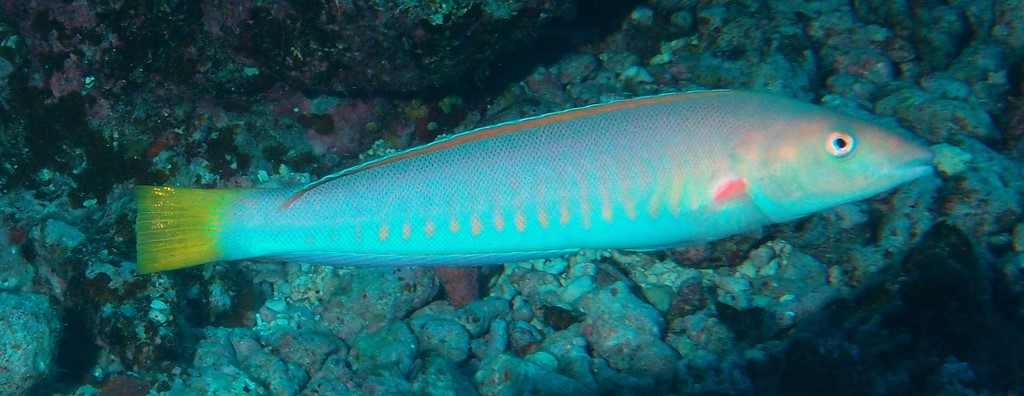HOLOGYMNOSUS LONGIPES - (GUNTHER, 1862)
Actinopterygii (Gigaclass) > Actinopteri (Class) > Teleostei (Subclass) > Labriformes (Order) > Labroidei (Suborder) > Labridae (Family) > Hologymnosus (Genus)
Pale slender wrasse, Pale slender-wrasse, Sidespot ringwrasse, 長鰭細鱗盔魚,
Synonyme
Coris longipes (Günther, 1862)
------------------------
Description
Dorsal spines (total): 9; Dorsal soft rays (total): 12; Anal spines: 3; Anal soft rays: 12; Pectoral fin rays: 13; Lateral line scales: 95-100; Gill rakers: 19-21; Body elongate, the depth: 4.65-5.5 in SL. Caudal fin slightly rounded to truncate, the corners sometimes a little prolonged. Pectoral fin short: 1.9-2.0 in Head; Pelvic fin relatively long: 2.15-2.4 in Head Long. Max. length: 40.0 cm TL. Depth range: 5 - 30 m.
Color
Etymology
Hologymnosus: from Greek, hólos = whole, full + from Greek, gymnos = naked. Described as lacking “any easily visible scales”; In actuality, its scales are small but its head is scaleless.
longipes: from Latin, longus = long + from Latin, pes = foot. Referring to prolonged outer rays of ventral fin, as long as pectoral fin.
Original description: Coris longipes Günther, 1862 - Type locality: Aneiteum Island, Vanuatu.
Distribution
Western Pacific: West Australia, Coral sea, New Caledonia and Vanuatu.
Biology
Inhabits lagoon and seaward reefs, usually over sandy or rubble areas near coral heads. Oviparous, distinct pairing during breeding. Aquarium fish.
Last update: 6, April 2023
Pale slender wrasse, Pale slender-wrasse, Sidespot ringwrasse, 長鰭細鱗盔魚,
Synonyme
Coris longipes (Günther, 1862)
------------------------
Description
Dorsal spines (total): 9; Dorsal soft rays (total): 12; Anal spines: 3; Anal soft rays: 12; Pectoral fin rays: 13; Lateral line scales: 95-100; Gill rakers: 19-21; Body elongate, the depth: 4.65-5.5 in SL. Caudal fin slightly rounded to truncate, the corners sometimes a little prolonged. Pectoral fin short: 1.9-2.0 in Head; Pelvic fin relatively long: 2.15-2.4 in Head Long. Max. length: 40.0 cm TL. Depth range: 5 - 30 m.
Color
- Initial phase light greenish yellow to bluish grey with two series of vertically elongate orange spots on body that continue onto head as solid stripes, caudal fin orange to yellow.
- Terminal male body light greenish dorsally, white ventrally, with orange bars on side that become pale lavender-blue to purple bars anteriorly on lower side, an oval black spot on side of body dorsal to pectoral fin, head green with pink bands radiating from eye, caudal fin blue with a large, whitish semicircular area posteriorly.
Etymology
Hologymnosus: from Greek, hólos = whole, full + from Greek, gymnos = naked. Described as lacking “any easily visible scales”; In actuality, its scales are small but its head is scaleless.
longipes: from Latin, longus = long + from Latin, pes = foot. Referring to prolonged outer rays of ventral fin, as long as pectoral fin.
Original description: Coris longipes Günther, 1862 - Type locality: Aneiteum Island, Vanuatu.
Distribution
Western Pacific: West Australia, Coral sea, New Caledonia and Vanuatu.
Biology
Inhabits lagoon and seaward reefs, usually over sandy or rubble areas near coral heads. Oviparous, distinct pairing during breeding. Aquarium fish.
Last update: 6, April 2023
